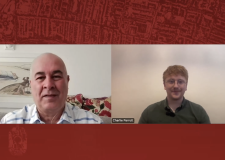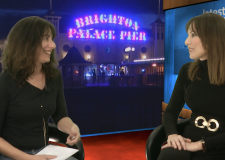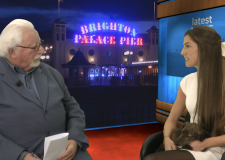The burning question about Lewes Bonfire
Is Lewes Bonfire an important commemoration or a good excuse for a party?
The Bonfire prayers implore us to “Remember, remember the Fifth of November, the Gunpowder treason and plot”.
And every year thousands take part in the processions, and tens of thousands more line the narrow streets of Lewes for the best Bonfire Night in Britain.
It would be wrong to say that Brighton empties out for the evening to descend on Lewes en masse – but you could be forgiven for thinking that that’s what happens.
How much remembering goes on? For many of the people who turn up on the night, surely it’s just an excuse for one of the wildest parties of the year?
We have become so secular that it’s hard to imagine the sectarian nature of the struggle personified by the gunpowder plotters – Guy Fawkes and a dozen others – as they sought to blow up Parliament.
Their aim was to kill the Protestant King and replace him with a Catholic.
 King James was sufficiently relieved to have survived the foiled plot that he declared the Fifth of November a day of thanksgiving each year by Act of Parliament.
King James was sufficiently relieved to have survived the foiled plot that he declared the Fifth of November a day of thanksgiving each year by Act of Parliament.
He encouraged people to celebrate by lighting bonfires so long as “this testemonye of joy be carefull done without any danger or disorder”.
Sussex Police does its best each year to keep the “danger or disorder” to a minimum – sometimes in a way that appears to strain relations with the bonfire societies.
Given the size of the crowds craning to see the processions and the barrel runs, with flaming tar barrels racing down the High Street, officers have an unenviable task. And the societies jealously guard their freedoms and their independence.
But for all the dark undertones that seem to infuse the smoke-filled night, it is generally a raucous but good-natured gathering.
The pubs and restaurants do a roaring trade, although from time to time some pubs have restricted entry to regulars. And try booking a hotel in Lewes on Bonfire Night.
It probably goes without saying that the hospitality sector enjoys a reliable boost.
Keith Austin is secretary of Southover Bonfire Society – one of six societies due to parade tomorrow (Saturday).
He said: “It does do Lewes a lot of good. Getting accommodation can be difficult. Street vendors pay for a licence for the day.
“Being on a Saturday this year, a lot of people will get here early. They’ll buy lunch, go to restaurants for dinner. Pelham House Hotel is having a barbecue. And the amount of money collected for charity in the buckets is quite a considerable sum.”
If anyone has spoken up over the years for those taking part and their traditions, it is Mr Austin, a life member of three different societies and former secretary of the Lewes Bonfire Council.
He once faced Cardinal Cormac Murphy-O’Connor, then the Bishop of Arundel and Brighton, on Radio 4.
The Catholic bishop indicated that he wasn’t happy at the idea of revellers burning an effigy of the Pope.
He sounded much less troubled on learning that the effigy was Pope Paul V – the man who was Pope in 1605, the year of the Gunpowder Plot.
 Mr Austin said: “I always tell people that Lewes is not anti-Catholic. It’s more pro-Protestant. In Bonfire there are a lot of Catholic people. It’s about history. There’s nothing sinister about it.”
Mr Austin said: “I always tell people that Lewes is not anti-Catholic. It’s more pro-Protestant. In Bonfire there are a lot of Catholic people. It’s about history. There’s nothing sinister about it.”
There is a second strand to all this. Seventeen Protestant martyrs were burnt to death in Lewes in the 1550s during the reign of Queen Mary – Bloody Mary – during the long struggle for religious ascendancy.
Again, many of those involved with Bonfire say that there is no animosity in their remembrance. Not everyone agrees.
The Cliffe Bonfire Society still parades under a banner saying: “No Popery.”
It ruffled the feathers of a villager from nearby Newick enough a few years back for him to ask the police to intervene. His efforts were unsuccessful.
It certainly wasn’t the first time that the banner brought controversy.
On at least a couple of occasions in the past century the society has stood alone in defending its freedom of speech.
It was ostracised in the 1930s by the other societies. In the 1950s it declined to join the United Grand Procession as this was conditional on ditching the banner proclaiming No Popery.
If some on the Church of Rome have taken umbrage from time to time, the parish priests of St Pancras – from Canon Leonard O’Donnell onwards – have tended to err on the side of mature charity and diplomatic pragmatism. Not always and at all times, but mostly.
Some years back lifelong Lewes resident Ros Barry wrote to the Catholic newspaper The Universe to say: “Bonfire night in Lewes is enjoyed by people of all denominations and there is absolutely no animosity in any of the proceedings – indeed many Catholics actually participate in the proceedings.
“When the late Canon O’Donnell was parish priest in Lewes we had a bonfire night Mass just prior to the commencement of the bonfire celebrations at 4pm.
“We in Lewes have worked hard to nurture good relations with the bonfire societies and would not like this to be brought to an end by the hostilities of ‘outsiders’.”
Effigies of contemporary figures have been known to go on the bonfire. Osama bin Laden and George Bush have both been burnt as “enemies of bonfire”.
On one occasion Canon Eric Flood decried it as “moral racism” after the Bishop of Arundel and Brighton was burnt in effigy. He mellowed. By 2003 he told his parishioners that he felt “more benign” these days towards Bonfire.
He said in a parish newsletter: “After seven years I have become more aware of problems in the expression of what is another age.
“We don’t need to fight too hard over Protestant/Catholic issues any more. We have to live in charity and make allowances for the present time.”
 His successor Father Richard Biggerstaff tackled the issue with a touch of humour, establishing an annual lecture on the day before Bonfire, entitled Know Popery.
His successor Father Richard Biggerstaff tackled the issue with a touch of humour, establishing an annual lecture on the day before Bonfire, entitled Know Popery.
Although he recently moved to another parish, the lecture will take place today (Friday 4 November) with this year’s talk on an aspect of Catholic history being given by Father Seán Finnegan.
Father Ray Blake, of St Mary Magdalen in Brighton, said: “I think for most people it’s just a folk festival.
“I suspect people who might be burning the Pope on the fifth have forgotten about it on the sixth. There’s also the whole thing about being a night of misrule.”
The idea would, he said, be attractive to the new age element of the population in Brighton and Hove.
He acknowledged that the burning of the Protestant martyrs lived on in the folk memory of Lewes, which may help explain the survival of Bonfire there, and added: “There is a folk memory of Tom Payne in Lewes too.”
The recently arrived parish priest of St Pancras, Father Jonathan Martin, has relatives coming to stay this weekend.
He said that, while he was new to the area, he and his family would be enjoying the spectacle of the fireworks.
One Bonfire regular said that while the whole event was a glorified party for many, there were a few thoughtful people involved who were mindful of a modern resonance.
He said that the religious intolerance and division of the 16th and 17th centuries had echoes still in the streets of Belfast and Glasgow. And, in a different guise, in the tensions between Islam and other religions – Christianity in the West, Hinduism in the Indian sub-continent.
He said that Oliver Cromwell cracked down on Bonfire and other forms of entertainment and that this was mirrored to an extent in the way that religious fundamentalists tried to impose their joyless views on those around them in many parts of the world today.
But it was a sign of a society more at ease with itself, and certainly more tolerant, that whatever effigies were burnt and whatever the Bonfire prayers invoked, the Fifth tended to pass in a relatively trouble-free way.
He compared it favourably with the marching season in Northern Ireland and said: “Sometimes here there’s a hint of a frisson on the Fifth but we’ve moved on together.
“We might be a bit rowdy and a few people might take offence, but when all’s said and done, I think we set a pretty good example. We live well together.
“Past rivalries and dark deeds are remembered for sure. But at the end of the day, we burn the Guy, we set off fireworks and we have a barrel of fun.”




















